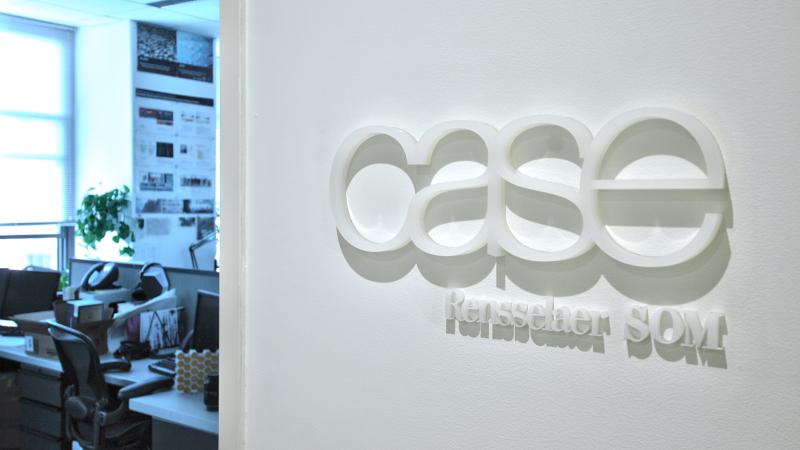December 18, 2017

When it was established 10 years ago, the Center for Architecture Science and Ecology (CASE) created a new collaborative model for built ecology research and accelerated innovation that united interdisciplinary academic research and pedagogy with the building and development practices of a private-sector firm. Created to address the need for accelerated innovation and implementation of next-generation sustainable built environments by merging academic and industrial research interests, CASE’s work addressed challenges within buildings: energy consumption, indoor environmental quality, water harvesting and reuse, fragile ecosystem remediation, and material resource concerns to develop next-generation building systems and materials that dramatically improve the performance of buildings. The idea was to tap and cultivate the talents of a new generation of architects, thinkers, scientists, and planners and turn out sustainable and energy-efficient solutions to today’s environmental challenges in the global building sector, which accounts for more than one-third of energy consumption and nearly 40 percent of carbon production. A multi-institutional professional office research collaboration between Rensselaer Polytechnic Institute (RPI) and Skidmore, Owings & Merrill LLP (SOM), the world-renowned architecture and engineering firm, CASE was headed by Dr. Anna Dyson, professor of architecture, leading a team of researchers working alongside SOM partners.
Over this past decade, CASE has developed a wide range of innovative design concepts for the built environment, focused on implementing changes in energy consumption, quality of access to essential resources, and sustainable resource management. Examples include dynamic next-generation materials, graphene technology, socio-ecological visual analytics, and a façade system, called the Electroactive Dynamic Display System (EDDS), which works as an alternative to existing dynamic glazing technologies and integrates electroactive polymers within glazed envelopes for enhanced energy-efficiency. Other innovative design concepts include active hydroponic systems for air purification and energy reduction in building systems – a “green wall” technology platform that was most recently integrated into the new Public Safety Answering Center II (PSAC II) building, designed by SOM. Called the Active Modular Phytoremediation Wall System (AMPS), this “green wall” technology is particularly innovative for its ability to produce fresh air from within buildings by amplifying the air-cleaning capacity of plants. By recirculating air across the plants’ rhizosphere, this method has been shown to clean air up to 200 times more efficiently than plant leaves. CASE has also worked to develop a kinetic solar façade, a photovoltaic system – integrated architecturally into a building’s façade or roof – that takes an inventive approach to reducing solar gain while providing a building with enhanced daylighting, electrical power, and thermal energy. CASE has hosted the RPI School of Architecture’s Graduate Program in Architectural Sciences/Built Ecologies, and in 2012, received the prestigious ACADIA Award of Excellence for Innovative Academic Programs. In response to its pioneering research, CASE has also received numerous grants, including from the National Science Foundation, U.S. Department of Energy, New York State Energy Research and Development Agency, and the Gates Foundation, among others.
Since it was launched, it was understood that after the first decade of innovation, CASE would likely take on different forms as it moved into the future. Effective January 1, 2018, Dyson will assume the position of Hines Professor of Architecture at Yale University in New Haven, Connecticut, and RPI will initiate an international search for a new director. In the interim, Professor Robert Hull, Director of the Center for Materials, Devices, and Integrated Systems, will assume the role of Administrative Director and CASE educational activities will be overseen by Professor Evan Douglis, Dean of the School of Architecture.
“The achievements and accelerated innovations that CASE has made have proved our basic point – that the most meaningful performative design innovations will be achieved by collaboration between the leaders in academic research and transdisciplinary professional practice,” said SOM Partner Kenneth A. Lewis. “As CASE moves into its next iteration, we know that it will continue to create an environment that will advance building science to the forefront of creative endeavors.”
"Since its inception, CASE had been dedicated to developing next generation building systems for a sustainable planet. Its unique model of interdisciplinary engagement was established from the start in response to a complex and changing planet requiring a broad range of academic and industry expertise necessary for the discovery of a new era of sustainable technologies. The innovative research that has emerged over the years, in collaboration with SOM, has been transformational as proof that architecture should be pursued as an integrated project comprised of pioneering design, technology and science,” said Dean Evan Douglis. “We are grateful for Professor Anna Dyson’s visionary leadership, and have every intention, as we move CASE forward in the coming years, to continue as a world leader in the discovery of novel sustainable technologies."